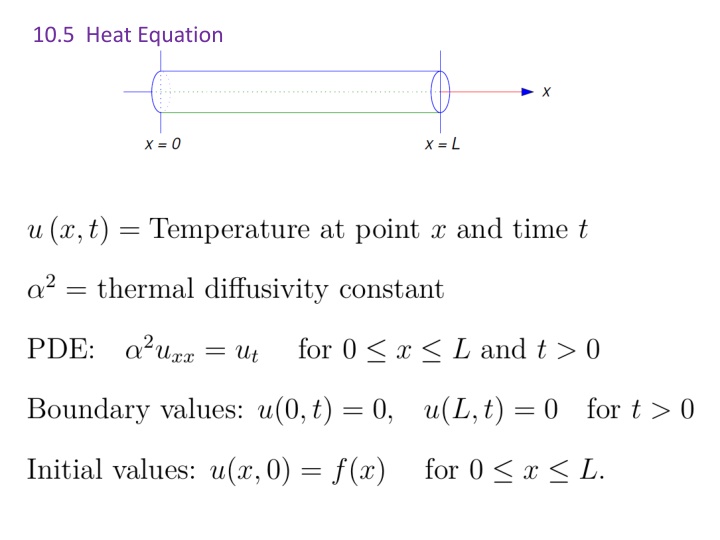
Heat Equation Solutions through Separation of Variables
Explore the method of Separation of Variables to solve the heat equation, finding general solutions and obtaining linear homogeneous ODEs. Learn when a function of x is equal to a function of t and delve into the intricacies of this mathematical technique.
Download Presentation

Please find below an Image/Link to download the presentation.
The content on the website is provided AS IS for your information and personal use only. It may not be sold, licensed, or shared on other websites without obtaining consent from the author. If you encounter any issues during the download, it is possible that the publisher has removed the file from their server.
You are allowed to download the files provided on this website for personal or commercial use, subject to the condition that they are used lawfully. All files are the property of their respective owners.
The content on the website is provided AS IS for your information and personal use only. It may not be sold, licensed, or shared on other websites without obtaining consent from the author.
E N D
Presentation Transcript
Solve to find general solution: And then plug in initial values to find constants:
Solve to find general solution: Method: Separation of Variables Note: This is a big assumption Are there other solutions?
When does a function of x = a function of t? I.e., when does f(x) = g(t) for all x, t? If f(x) = sin(x), is there a g(t) = f(x)?
When does a function of x = a function of t? I.e., when does f(x) = g(t) for all x, t? If f(x) = sin(x), is there a g(t) = f(x)? If f(x) = 2, is there a g(t) = f(x)?
Method: Separation of Variables - is the separation constant.
10.1: Eigenvalue Problems Solve the following for nontrivial solutions:
http://tutorial.math.lamar.edu/Classes/DE/BoundaryValueProblem.aspx
http://tutorial.math.lamar.edu/Classes/DE/BoundaryValueProblem.aspx
10.1: Eigenvalue Problems Solve the following for nontrivial solutions:
10.1: Eigenvalue Problems Solve the following for nontrivial solutions: Recall is an arbitrary constant. Note we are only interested in values for for which the above boundary value problem has non-trivial solutions. For what values of , does the above have a nontrivial solution for X(x)?
is an eigenvalue of A if Ax = x has nontrivial solutions. If v is a nonzero solution to Ax = x, then v is called an eigenvector of A with eigenvalue . Note nonzero linear combinations of eigenvectors with eigenvalue are also eigenvectors. ____________________________________________________________________________________ is an eigenvalue of the BVP if this BVP has nontrivial solutions. If X is a nontrivial solution f to this BVP, then f is called an eigenfunction of the BVP with eigenvalue . Note nonzero linear combinations of eigenfunctions with eigenvalue are also eigenfunctions.
http://tutorial.math.lamar.edu/Classes/DE/BoundaryValueProblem.aspx
http://tutorial.math.lamar.edu/Classes/DE/BoundaryValueProblem.aspx is NOT an eigenvalue of the BVP
http://tutorial.math.lamar.edu/Classes/DE/BoundaryValueProblem.aspx
http://tutorial.math.lamar.edu/Classes/DE/BoundaryValueProblem.aspx is an eigenvalue of the BVP Eigenfunctions
Thus = 0 is not an eigenvalue for this BVP since the only solution is trivial.
Since is negative, we have two real roots. Lots of work will show that the only solution to this BVP is trivial when the roots are real Thus < 0 is not an eigenvalue for this BVP since the only solution is trivial.
The nontrivial solutions to this BVP include Where Principle of superposition for linear homogeneous ODEs: Linear combinations of solutions are also solutions.
Solve to find general solution: And then plug in initial values to find constants:
